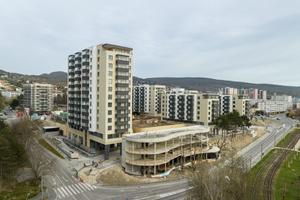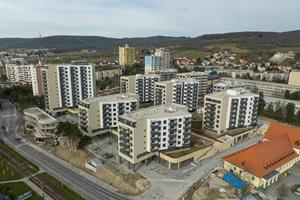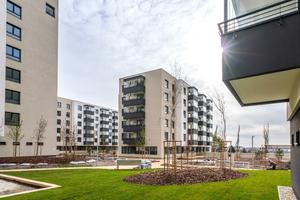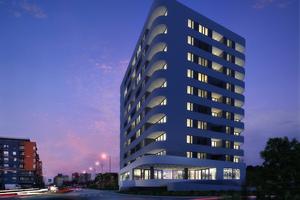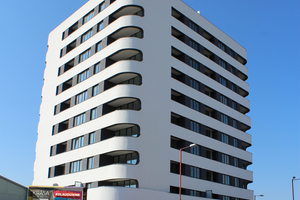Zoning plans in their current form, which are a remnant of the communist regime, are outdated, often lag current needs, and are too strict. This hobbles developers as well as citizens when it comes to deciding what should be built in a given area. One solution is to design modifiable projects, says Martin Šimurda, manager of the Bencont Group from Bratislava.
Describe the post-pandemic development in the residential market.
The sharp post-pandemic economic rebound also affected the real estate market. Interest in real estate, supported by deferred demand and low interest rates, rose sharply, resulting in double-digit increases in the prices of flats. In Bratislava, the prices of new flats have increased by 36 percent since 2020, from €3,600/m² to €4,900/m² including VAT. In absolute terms, this represents an increase from €235,000 for an average large apartment to €295,000. Similarly, older apartments sold on the secondary market became more expensive, to the point where an average apartment cost €265,000 at the end of 2022.
This sharp growth was not just due to a recovery in demand, but also a limited supply, which has two main causes. The first is the slowdown in construction, caused first by the pandemic and later by the war in Ukraine. The second reason is the long-term shortage of residential real estate in desirable areas, especially Bratislava.
The capital has long suffered from a complicated and years-long permitting process, as well as a zoning plan that allows very limited construction of new housing. This resulted in a drop in vacant flats sold in new projects to 1,660 in the first quarter of 2022. This is the lowest number in 20 years. The situation changed in the second half of 2022, when the economy was hit by the energy crisis, double-digit inflation and a sharp rise in interest rates. In particular, higher interest rates made mortgages more expensive. This, together with general nervousness about further economic development, caused a slump in demand. The sales of flats in Bratislava in 2022 were the weakest since the financial crisis of 2008 and prices have been stagnating since the second quarter of 2022.
What impact has the rise in input prices had on residential property prices?
It has certainly been significant, especially in locations with lower selling prices. The price of construction work has increased by 36 percent since the end of 2020, while prices for building materials have risen by 41 percent. Land prices and financial costs also rose significantly. Despite the sharp increase in the prices of flats, there was no massive expansion of development margins, especially for new projects and locations with a lower sale price. So, many developers have decided to delay new construction.
How has Bencont addressed this growth?
Most of the flats under construction in our projects were in the final stage of shell construction when building materials and work increased in price. This meant that we were only partially affected by the significant increase in the prices of some materials, such as iron and steel, insulation materials and window panels. In the case of buildings in the initial stages of construction, we tried to combine savings and pass on part of the price increase to suppliers. Last but not least, it was also important for us to adjust our sales strategy. This meant that we put the flats on sale gradually, and in stages. So we avoided a situation where we would have sold flats at fixed prices, but did not have fixed prices for construction work with suppliers. As a consequence, we were not forced to apply inflation clauses in our projects.
What further developments do you expect in this regard?
We do not expect further increases in input prices at this point. On the contrary, we believe that there will be some fall in the prices of building materials, both due to the fall in the prices of the energy and commodities necessary for their production, as well as lower demand for construction work. Many developers have suspended some new construction as sales slowed in the stages already under construction. In addition, due to the explosive increase in the prices of construction work and materials, margins have been pushed to the minimum in cheaper locations, which represents too great a risk for many developers to embark on new projects.
How do you perceive the re-evaluation of some office projects, along with the fact that some developers have decided to build flats instead of offices?
In the current situation, this makes sense, as long as the zoning plan allows the developer to do so. While office occupancy is increasing, the uncertain macroeconomic environment and the work-from-home trend are raising concerns about future demand. A very significant factor is the increase in interest costs, which makes it more expensive for landlords to finance office buildings. At the same time, they can pass on only part of these costs to tenants through increases in rent.
How does the construction of new residential districts differ from the construction of individual apartment buildings?
The construction of individual buildings is faster and easier. The developer usually buys a small plot of land, which means significantly lower financial costs. Also, such land often comes with a certain degree of permits leading to construction, which means the faster completion of the project and partial elimination of uncertainty on future market developments. However, there are few such plots in Bratislava today and they are usually accompanied by some type of restriction on future development.
On the other hand, the construction of new residential districts is naturally much more complex and significantly more demanding in financial terms, since the acquisition of a large plot of land is necessary. On top of that, a change of the current zoning plan is necessary, which is a years-long process with an uncertain outlook. So the whole process, from the acquisition of land to the completion of construction, can take more than 10 years, which poses a huge risk for the developer. However, if such a project is successful in its first phases, the developer’s margin at later phases may be significantly higher.
Where does Bencont get inspiration when designing its residential projects?
We always prepare our projects with architects. We examine the environment in which the project is located, as well as the overall urban concept of the site and the environment. Each place has its own specifics and some history that we mustn’t forget. After all, we want to leave something positive behind. Of course, the focus is on the architect, but it’s always a creative process in which we interact and complement each other.
How much opportunity does the developer have to influence the future shape of new residential areas, including civic amenities?
The zoning plan is always decisive for the overall look of a development project. Unfortunately, this document in its current form is a remnant of the previous regime’s planning, and often greatly limits developers as well as citizens in deciding what will be useful in terms of building in a given area. Not to mention that times are changing, yet the zoning plan frequently lags behind and does not respond to current needs in a timely way. So we strive to implement projects so that they are modifiable.
How can developers help municipalities with public-benefit investments?
There are two types of assistance. The first comprises investments related to your project that need to be implemented for the project to work as it should. Here we are talking mainly about infrastructure, intersections, bus stops and sidewalks. The second is the development fee, created precisely for this purpose. In our Rínok Rača project this served to help with the completion of a local primary school.
What further developments do you expect to see in the residential market?
In the first half of 2023, due to rising interest rates and the uncertain macroeconomic situation, we expect the current stagnation of new housing prices in Bratislava to continue. Developers will slow down further construction, so we won’t assume a significant expansion of the offer. We expect a partial recovery of demand in the second half of year.

This article has been brought to you by BENCONT DEVELOPMENT.


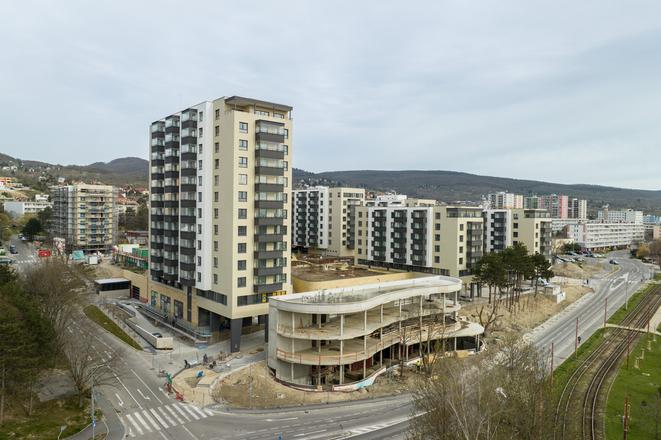
 Martin Šimurda, Manager at BENCONT DEVELOPMENT
Martin Šimurda, Manager at BENCONT DEVELOPMENT
